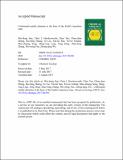Carbonated mantle domains at the base of the Earth's transition zone
Abstract
The oxygen fugacity of the upper mantle is 3–4 orders of magnitude higher than that of the lower mantle and this has been attributed to Fe2+ disproportionating into Fe3+ plus Fe0 at pressures > 24 GPa. The upper mantle might therefore have been expected to have evolved to more oxidizing compositions through geological time, but it appears that the oxygen fugacity of the upper mantle has remained constant for the last 3.5 billion years. Thus, it indicates that the mantle has been actively buffered from the accumulation of Fe3+, and that this is linked to oxidation of diamond to carbonate coupled with reduction of Fe3+ to Fe2+. When subducted plates penetrate into the lower mantle, compensational upwelling transports bridgmanite into the transition zone, where it breaks down to ringwoodite and majorite, releasing the ferric iron. The system returns to equilibrium through oxidation of diamond. Early in Earth history, diamond may have been enriched at the base of the transition zone in the Magma Ocean, because it is denser than peridotite melts at depths shallower than 660 km, and it is more buoyant below. Ongoing oxidation of diamond forms carbonate, leading to relatively high carbonate concentrations in the source of ocean island basalts.
Citation
Sun , W , Hawkesworth , C J , Yao , C , Zhang , C , Huang , R , Liu , X , Sun , X , Ireland , T , Song , M , Ling , M , Ding , X , Zhang , Z , Fan , W & Wu , Z 2018 , ' Carbonated mantle domains at the base of the Earth's transition zone ' , Chemical Geology , vol. 478 , pp. 69-75 . https://doi.org/10.1016/j.chemgeo.2017.08.001
Publication
Chemical Geology
Status
Peer reviewed
ISSN
0009-2541Type
Journal article
Description
This study was supported by National Key R&D Program of China 2016YFC0600408, CASXDB18020000, NSFC91328204 to W.D.S., State Key Development Program of Basic Research of China (2014CB845905), NSFC41274087 to Z.Q.W. 41090371 to X.L. TRI acknowledges a Chinese Academy of Sciences President's International Fellowship for visiting scientists Grant No. 2015VEA003.Collections
Items in the St Andrews Research Repository are protected by copyright, with all rights reserved, unless otherwise indicated.

